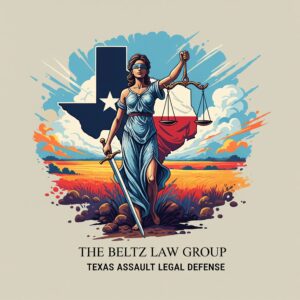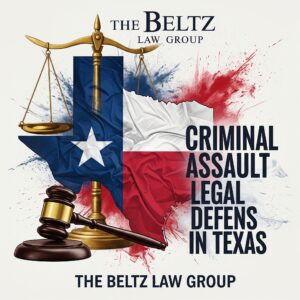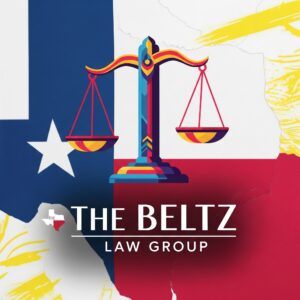Last Updated on July 21, 2025 by Beltz Law Group
Aggravated Assault with a Motor Vehicle in Texas: Understanding This Serious Charge

Assault Defense Lawyer
A charge of aggravated assault in Texas is always serious, but when a motor vehicle is involved, the legal complexities and potential penalties escalate dramatically. You might be surprised to learn how easily a vehicle, an everyday mode of transportation, can be classified as a “deadly weapon” in the eyes of the law.
At The Beltz Law Group, our criminal defense attorneys have extensive experience defending individuals accused of aggravated assault with a motor vehicle across North Texas. We understand the nuances of this charge and are prepared to build a robust defense for your case. After reading this article, we encourage you to call us at 214-321-4105 to schedule a confidential consultation.
What is “Aggravated Assault” in Texas?
To understand aggravated assault with a motor vehicle, it’s essential to first grasp the underlying offense of “assault.” Under Texas Penal Code Section 22.01, a person commits assault if they:
- Intentionally, knowingly, or recklessly cause bodily injury to another.
- Intentionally or knowingly threaten another with imminent bodily injury.
- Intentionally or knowingly cause physical contact with another when the person knows or should reasonably believe that the other will regard the contact as offensive or provocative.
Aggravated Assault occurs when an assault is committed under certain aggravating circumstances. According to Texas Penal Code Section 22.02, a person commits aggravated assault if they commit an assault and:
- Cause serious bodily injury to another (including their spouse); OR
- Use or exhibit a deadly weapon during the commission of the assault.
The Motor Vehicle as a “Deadly Weapon”

Assault Defense Attorney Texas
This is often the most critical and misunderstood aspect of an aggravated assault charge involving a vehicle. In Texas, a motor vehicle is not inherently a deadly weapon like a firearm. However, it can become one based on how it is used.
Texas Penal Code Section 1.07(a)(17) defines a “Deadly Weapon” as: (A) a firearm or anything manifestly designed, made, or adapted for the purpose of inflicting death or serious bodily injury; or (B) anything that in the manner of its use or intended use is capable of causing death or serious bodily injury.
Under subsection (B), courts have consistently held that a motor vehicle can be classified as a deadly weapon if it was used in a way that was “capable of causing death or serious bodily injury.” This doesn’t require actual death or serious injury, only that the manner of its use posed that potential danger.
As established in case law, a vehicle may be considered a deadly weapon where it was intentionally, knowingly, or recklessly used as a weapon by the accused. A deadly weapon finding is justified if a rational jury could conclude that the defendant’s vehicle posed an actual danger of death or serious bodily injury.
What is “Serious Bodily Injury”?
“Serious bodily injury” is defined in Texas Penal Code Section 1.07(a)(46) as “bodily injury that creates a substantial risk of death or that causes death, serious permanent disfigurement, or protracted loss or impairment of the function of any bodily member or organ.” This is a higher threshold than “bodily injury,” which just means physical pain, illness, or any impairment of physical condition.
Penalties for Aggravated Assault with a Motor Vehicle

Aggravated Assault Defense Attorney
Generally, aggravated assault with a motor vehicle is a Felony of the Second Degree.
- Punishment: 2 to 20 years in state prison and/or a fine of up to $10,000.
However, the charge can be elevated to a Felony of the First Degree (5 to 99 years or life in state prison and/or a fine of up to $10,000) under certain circumstances, including:
- If the assault causes serious bodily injury to a family member or someone with whom the defendant has a dating relationship.
- If the assault causes a traumatic brain or spinal injury resulting in a persistent vegetative state or irreversible paralysis.
- If the assault is committed against a public servant (e.g., police officer, firefighter, judge) while they are performing their duties, or in retaliation for their official duties.
- If the assault is committed against a witness, prospective witness, informant, process server, or security officer while they are performing their duties or in retaliation for their service.
- If the actor is in a motor vehicle and knowingly discharges a firearm at or in the direction of a habitation, building, or vehicle, is reckless as to whether it is occupied, and causes serious bodily injury to any person. (Note: This specific enhancement is for shooting from a vehicle, not necessarily using the vehicle as the weapon.)
- If the assault is committed as part of a mass shooting.
Key Elements the Prosecution Must Prove
For an aggravated assault with a motor vehicle charge, the prosecution must prove, beyond a reasonable doubt, that the defendant:
- Committed an assault (e.g., intentionally, knowingly, or recklessly caused bodily injury).
- Used or exhibited their motor vehicle.
- The motor vehicle, in the manner of its use, was capable of causing serious bodily injury or death.
- The defendant acted with the necessary “culpable mental state” (intentionally, knowingly, or recklessly) regarding the assault.
Understanding Mental States: Intentional, Knowing, and Reckless

Attorney For Assault Case
The prosecution doesn’t necessarily have to prove you intended to cause serious harm with your vehicle. The Texas Penal Code defines culpable mental states as follows:
- Intentionally: When it is your conscious objective or desire to engage in the conduct or cause the result.
- Knowingly: When you are aware of the nature of your conduct or that the circumstances exist, or you are aware that your conduct is reasonably certain to cause the result.
- Recklessly: When you are aware of but consciously disregard a substantial and unjustifiable risk that the circumstances exist or the result will occur. The risk must be of such a nature and degree that its disregard constitutes a gross deviation from the standard of care that an ordinary person would exercise under all the circumstances as viewed from the actor’s standpoint.
Even if you didn’t intend to harm someone with your vehicle, acting recklessly by driving in a way that poses a clear danger could lead to an aggravated assault charge if serious bodily injury occurs or if the vehicle is deemed a deadly weapon.
Case Example: Nguyen v. State (506 S.W.3d 69)
A real-world example illustrates how a motor vehicle can be classified as a deadly weapon:
In the case of Thien Quoc Nguyen v. The State of Texas, Nguyen was convicted of aggravated assault with a deadly weapon. The evidence showed that Nguyen intentionally drove his car in front of a motorcycle and slammed on his brakes, forcing the motorcyclist to crash and sustain serious injuries.
The court found that a rational jury could have concluded that Nguyen’s vehicle, in the manner of its use (i.e., intentionally cutting off and slamming on brakes in front of a motorcycle), posed an actual danger of death or serious bodily injury. This action, even without direct physical contact, was sufficient for the jury to find the vehicle was used as a deadly weapon and that Nguyen acted with a culpable mental state. Nguyen was sentenced to forty-seven years’ imprisonment due to prior enhancement and habitual-offender allegations.
This case highlights that the vehicle itself doesn’t need to make contact with the victim; the dangerous manner of its use is enough.
Why You Need an Experienced Criminal Defense Attorney
An aggravated assault with a motor vehicle charge is a felony that carries severe penalties, including lengthy prison sentences. The complexities of proving “deadly weapon” status and the required mental state mean that these cases require a highly skilled legal defense.
An attorney from The Beltz Law Group can:
- Investigate the facts: Scrutinize police reports, witness statements, accident reconstruction, and any available video evidence.
- Challenge the “deadly weapon” finding: Argue that the manner of your vehicle’s use did not meet the legal threshold for a deadly weapon.
- Dispute intent or recklessness: Present evidence or arguments to challenge the prosecution’s claim regarding your mental state.
- Negotiate with prosecutors: Seek reduced charges, alternative sentencing, or dismissal of the case.
- Represent you in court: Aggressively defend your rights at every stage of the legal process.
If you have been charged with aggravated assault with a motor vehicle in Texas, do not hesitate to seek legal help immediately. The stakes are incredibly high, and a strong defense can make all the difference. Contact The Beltz Law Group today to schedule your consultation.








